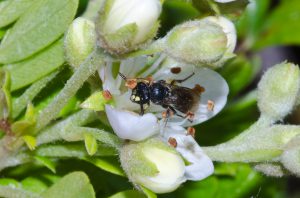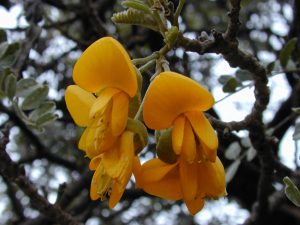First Bees Added to Endangered Species List.
WORLD IS EXPERIENCING A DECLINE IN POLLINATORS, NEW JERSEY IS NO EXCEPTION
By Kendall Miller
New Jersey is not exempt from the worldwide decline in pollinators. We face the challenge of protecting wildlife in a highly modified and populated landscape. But the fight is not without hope.
A milestone has been reached for wildlife conservation in Hawaii – and is a win for the world of conservation as a whole. This month, seven species of bees indigenous to the Hawaiian archipelago were added to the endangered species list and brought under federal protection. These are the first species of bees to be listed in the country.

Many of our native pollinators in the United States are on the decline, and New Jersey is no exception. Two pollinators from New Jersey – the monarch butterfly and the rusty patch bumble bee – have both been recommended for listing as well, and we could see their official listing the near future.
While a species being listed elicits feelings of dread and despair – instead it can be thought of as an opportunity and an impetus for action. The listing of these Hawaiian bees is exciting news for pollinator conservation, because these species are now brought under federal protection. Native pollinators, like these bees, are essential both for the functioning of their native ecosystems as well as human agriculture, so listing and protecting native pollinators benefits our very lives.
Hawaii and the Larger Picture
Native Hawaii wildlife and their habitats face an onslaught of challenges to their existence. Rapid habitat loss and urbanization of the islands have resulted in the blatant loss, fragmentation, and the degradation of habitats. Invasive nonnative species also outcompete and disrupt the natural dynamic of ecosystems. The list of threats is astonishingly long, and all have been brought to the island in some way by people.
Unfortunately, this is a common theme – the same type of challenges threaten pollinators across the globe.
A United Nations report published in February estimated that worldwide 40% of invertebrate pollinators face extinction – a startling fact since nearly 75% of our crops rely on pollinators in some way. The decline and/or total loss of almost half of our most important pollinators would have huge implications for agriculture – what we eat, what we drink and the clothes that we wear.
The listing of these species recognizes their importance and the imminence of the threats facing their existence. It brings to light the plight of pollinators as a whole and the need for their protection.
Listing species in the hopes that one day they may be taken off of that list. In New Jersey, we know the stories of the All-American comeback of our osprey, bald eagles and peregrine falcons. It is our hope that all rare wildlife can make the same comeback.
We can work to protect our pollinators in very real ways – even on the individual level. Everyone can be a steward to their environment with a little knowledge and compassion.
The Story of ‘Nalo Meli Maoli’ – Hawaii’s Native Bees
The bees of the Hawaiian archipelago have a unique story, but unfortunately their plight is all too familiar.
The Hawaiian islands are the most isolated island archipelago in the world, and because of this they have a unique natural history. With such little interchange of species, no other place has harbored the evolution of so many endemic species. Islands are fascinating places to examine the evolution of species. Like Darwin’s famed finches, where dozens of species descended from one common ancestor, all of which have adapted to fulfill a different niche – the bees of Hawaii tell a similar tale.
Only one type of bee made it to the island, a bee of the genus Hylaeus, commonly known as yellow-faced bees. From that original colonist arose 63 different endemic species of yellow-faced bees, all adapted to various lifestyles and habitats, from the wettest to the driest forests, alpine deserts all the way to the coast.
These species are important pollinators of many important trees and shrubs. The non-native European honey bee was introduced to the island and does visit these plants as well, yet they are known as nectar robbers. Their long tongues allow them to drink the flower’s nectar without coming into contact with the pollen. Thus they often do not contribute to pollination like the native species do.

Aside from a few exceptions, these bees are not found where people live. Once described as “ubiquitous” many can only be seen in certain locations like in the mountains where native habitat still remain. The colonization of Hawaii by people has lead to rapid changes which threatens the existence of many bees, and not to mention many other species of animals and plants on the island. Nine of the endemic bees have not been seen in 80 years and could very well be extinct.
Rats, cattle, goats, and pigs alter the vegetation of the landscape in ways that the bees cannot tolerate, and so they disappear from these areas. Even introduced earthworms have been changing soil chemistry in ways that are impacting the native ecosystems and these bees. The bees feed almost exclusively on native flowers, so where these disappear, so do they.
Competition and direct predation by introduced species like the yellow crazy ant and the Argentine ant have wiped out the bees in certain areas. Even an introduced species of foreign yellow-faced bee has wound up on the island, which could pose serious issues since it has the potential to outcompete the highly specialized indigenous bees. These and several other introduced species of insects have found their ways to the island – altering the natural ecosystem dynamic and spelling disaster for native flora and fauna. Due to weak regulations on plant imports, the continued introduction of invasive species is unavoidable.
Unfortunately this story is all too familiar – the rapid habitat loss, fragmentation, and degradation caused by humans is the number one cause of extinction of species, followed by invasive non-native species as the second leading cause. Yet all is not without hope – while many have been lost, some species have been brought back from the brink of extinction.
Learn more:
Feeling inspired? Contact us at kendall.miller@conservewildlifenj.org to learn how you can get involved with pollinator work, which includes habitat restoration, native plantings of pollinator gardens, education, and public events.
You can also learn more about how you can make a difference for pollinators at these sites:
- Xerces Society for Invertebrate Conservation
- How familiar are you with all of NJ’s wild bee’s?
- UNEP reports on the world health of pollinators
- Learn more about the story of the ‘Nalo Meli Maoli’ – Hawaii’s Native Bees
- Want to know exactly what being ‘listed’ entails?
Kendall Miller is a Project Coordinator and Education Assistant for Conserve Wildlife Foundation
Discover more from Conserve Wildlife Foundation of NJ
Subscribe to get the latest posts sent to your email.